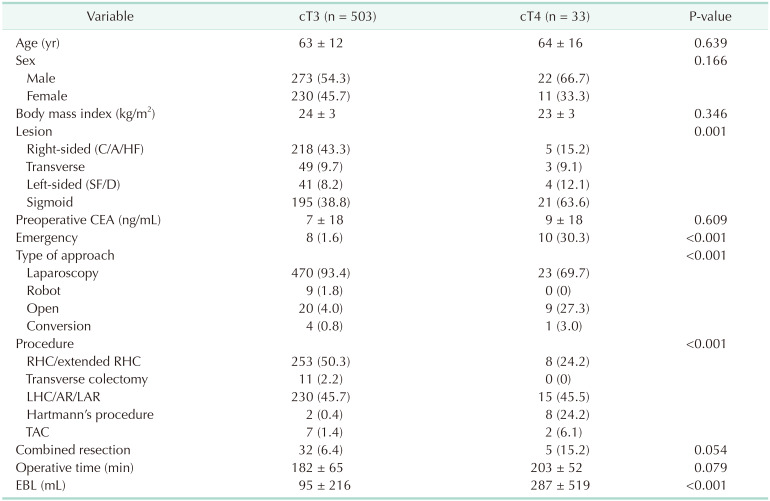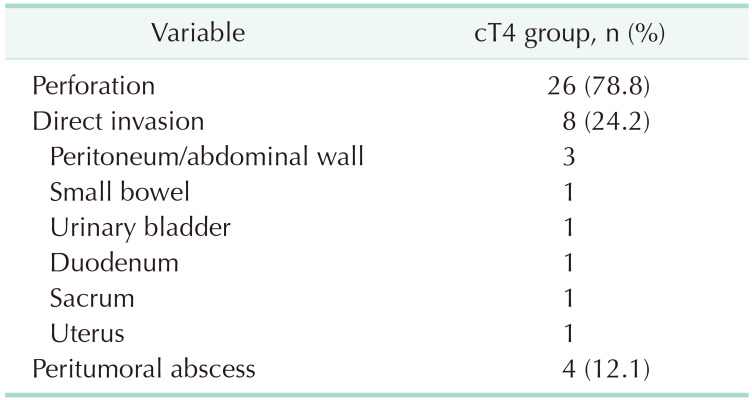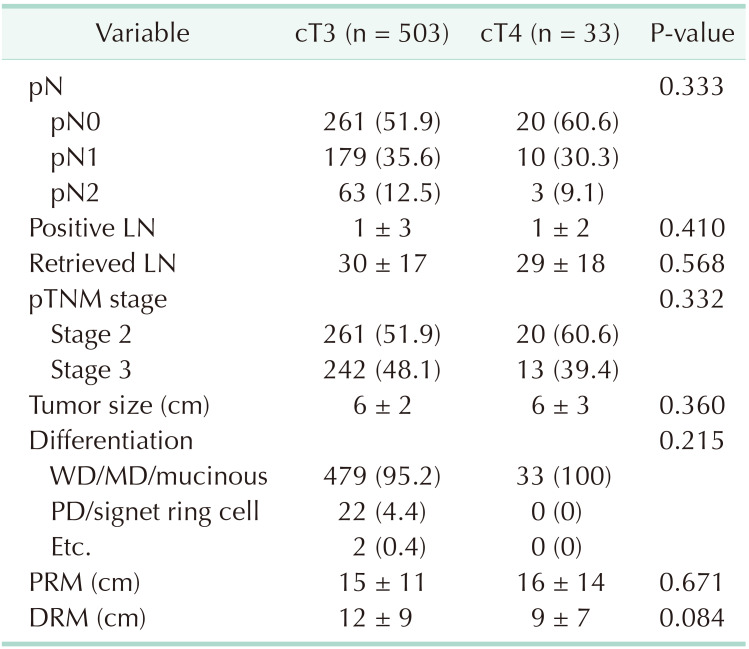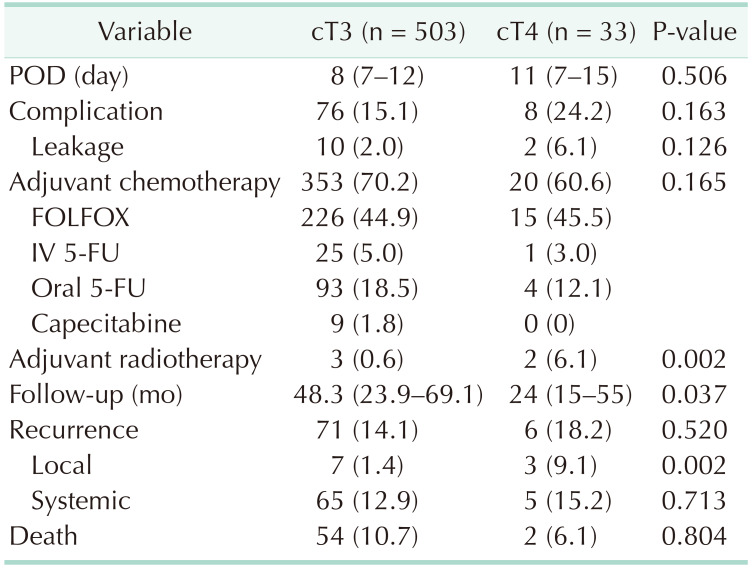1. Ferlay J, Soerjomataram I, Ervik M, Dikshit R, Eser S, Mathers C, et al. GLOBOCAN 2012: estimated cancer incidence, mortality and prevalence worldwide in 2012. Lyon: International Agency for Research on Cancer;2015.
2. National Cancer Center. Annual report of cancer statistics in Korea in 2015. Goyang (Korea): National Cancer Center;2017.
3. Sjovall A, Blomqvist L, Egenvall M, Johansson H, Martling A. Accuracy of preoperative T and N staging in colon cancer--a national population-based study. Colorectal Dis. 2016; 18:73–79. PMID:
26291535.
4. Elmas N, Killi RM, Sever A. Colorectal carcinoma: radiological diagnosis and staging. Eur J Radiol. 2002; 42:206–223. PMID:
12044699.
5. Thoeni RF. Colorectal cancer. Radiologic staging. Radiol Clin North Am. 1997; 35:457–485. PMID:
9087214.
6. Kijima S, Sasaki T, Nagata K, Utano K, Lefor AT, Sugimoto H. Preoperative evaluation of colorectal cancer using CT colonography, MRI, and PET/CT. World J Gastroenterol. 2014; 20:16964–16975. PMID:
25493009.
7. de Haan MC, van Gelder RE, Graser A, Bipat S, Stoker J. Diagnostic value of CTcolonography as compared to colonoscopy in an asymptomatic screening population: a meta-analysis. Eur Radiol. 2011; 21:1747–1763. PMID:
21455818.
8. Pham TT, Liney GP, Wong K, Barton MB. Functional MRI for quantitative treatment response prediction in locally advanced rectal cancer. Br J Radiol. 2017; 90:20151078. PMID:
28055248.
9. Will O, Purkayastha S, Chan C, Athanasiou T, Darzi AW, Gedroyc W, et al. Diagnostic precision of nanoparticle-enhanced MRI for lymph-node metastases: a metaanalysis. Lancet Oncol. 2006; 7:52–60. PMID:
16389184.
10. Figueiras RG, Goh V, Padhani AR, Naveira AB, Caamano AG, Martin CV. The role of functional imaging in colorectal cancer. AJR Am J Roentgenol. 2010; 195:54–66. PMID:
20566797.
11. Utano K, Endo K, Togashi K, Sasaki J, Kawamura HJ, Horie H, et al. Preoperative T staging of colorectal cancer by CT colonography. Dis Colon Rectum. 2008; 51:875–881. PMID:
18350337.
12. Nerad E, Lahaye MJ, Maas M, Nelemans P, Bakers FC, Beets GL, et al. Diagnostic accuracy of CT for local staging of colon cancer: a systematic review and metaanalysis. AJR Am J Roentgenol. 2016; 207:984–995. PMID:
27490941.
13. Kothari K, Friedman B, Grimaldi GM, Hines JJ. Nontraumatic large bowel perforation: spectrum of etiologies and CT findings. Abdom Radiol (NY). 2017; 42:2597–2608. PMID:
28493071.
14. Amin MB, Edge S, Greene F, Byrd DR, Brookland RK, Washington MK, et al. AJCC Cancer Staging Manual. 8th ed. New York: Springer International Publishing;2017.
16. White VA, Trotter MJ. Intraoperative consultation/final diagnosis correlation: relationship to tissue type and pathologic process. Arch Pathol Lab Med. 2008; 132:29–36. PMID:
18181670.
17. Asano H, Kojima K, Ogino N, Fukano H, Ohara Y, Shinozuka N. Postoperative recurrence and risk factors of colorectal cancer perforation. Int J Colorectal Dis. 2017; 32:419–424. PMID:
27796497.
18. Lee KY, Park JW, Song I, Lee KY, Cho S, Kwon YH, et al. Prognostic significance of sealed-off perforation in colon cancer: a prospective cohort study. World J Surg Oncol. 2018; 16:232. PMID:
30514318.
19. Belt EJ, Stockmann HB, Abis GS, de Boer JM, de Lange-de Klerk ES, van Egmond M, et al. Peri-operative bowel perforation in early stage colon cancer is associated with an adverse oncological outcome. J Gastrointest Surg. 2012; 16:2260–2266. PMID:
23093449.
20. Biondo S, Kreisler E, Millan M, Fraccalvieri D, Golda T, Marti Rague J, et al. Differences in patient postoperative and long-term outcomes between obstruc tive and perforated colonic cancer. Am J Surg. 2008; 195:427–432. PMID:
18361923.
21. Abdelrazeq AS, Scott N, Thorn C, Verbeke CS, Ambrose NS, Botterill ID, et al. The impact of spontaneous tumour perforation on outcome following colon cancer surgery. Colorectal Dis. 2008; 10:775–780. PMID:
18266887.
22. Chen HS, Sheen-Chen SM. Obstruction and perforation in colorectal adenocarcinoma: an analysis of prognosis and current trends. Surgery. 2000; 127:370–376. PMID:
10776426.
23. Petrelli F, Tomasello G, Borgonovo K, Ghidini M, Turati L, Dallera P, et al. Prognostic survival associated with left-sided vs right-sided colon cancer: a systematic review and meta-analysis. JAMA Oncol. 2017; 3:211–219. PMID:
27787550.
24. Boeckx N, Koukakis R, Op de, Rolfo C, Van Camp G, Siena S, et al. Primary tumor sidedness has an impact on prognosis and treatment outcome in metastatic colorectal cancer: results from two randomized first-line panitumumab studies. Ann Oncol. 2017; 28:1862–1868. PMID:
28449055.
25. Kim SR, Song N, Yothers G, Gavin PG, Allegra CJ, Paik S, et al. Tumour sidedness and intrinsic subtypes in patients with stage II/III colon cancer: analysis of NSABP C-07 (NRG Oncology). Br J Cancer. 2018; 118:629–633. PMID:
29241223.






 PDF
PDF Citation
Citation Print
Print







 XML Download
XML Download